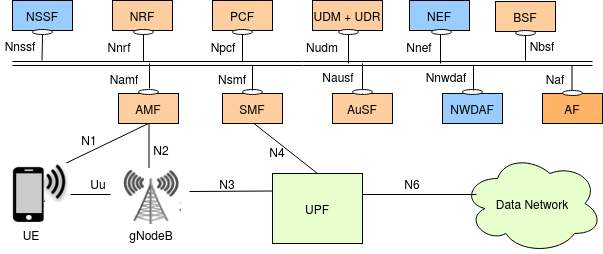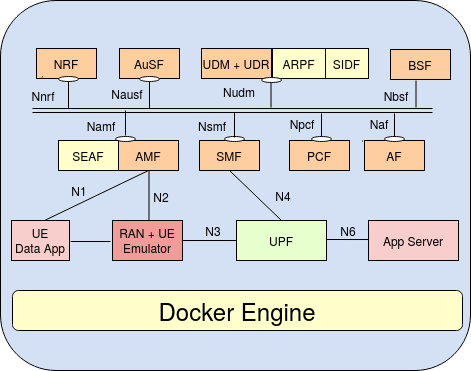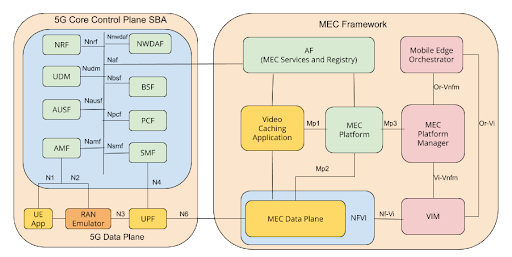5G Testbed
We are living in a world with breathtaking technological inventions. Starting from self-driving cars, to the remote operations in healthcare, there is no dearth of inventions. With these creative inventions uncovered every minute to improve the standards of living, there is a constant need for the fuel that will enable these technologies to function at their maximum potential. "The Internet, like the steam engine, was a breakthrough that changed the world"-Peter Singer, no doubt. But, we would not be wrong to state that "Fifth generation (5G) is the breakthrough, to enable the rapid increase in technology in the 21st century". 5G enables a new kind of cellular broadband that is designed to connect virtually everyone and everything together including machines, objects, and devices.
Huge data is generated in the growing 5G system from diverse types of devices and directions in connection with various industries like automotive, utilities, e-health, media and entertainment. The 5G system promises to serve the needs arising from these industries to satisfy the diversity of services to the end users in terms of throughput, latency and reliability by defining three major types of generic services, namely, enhanced Mobile BroadBand (eMBB), ultra Reliable Low Latency Communication (uRLLC), and massive Machine Type Communication (mMTC) or massive Internet of Things (mIoT).
There are efforts across the globe to build a complete end-to-end 5G system for prototyping 5G system networks and applications. In 2018, the Department of Telecommunications (DoT) funded a large-scale 5G test bed project, titled “Indigenous End-to-End 5G Test Bed Project”. This project focuses on building an end-to-end test bed setup with 5G prototypes for a real-world 5G deployment. The testbed project is jointly executed by various institutions including IIT Bombay, IIT Delhi, IIT Hyderabad, IIT Kanpur, IISc Bangalore, and other leading industry partners. The testbed comprises MIMO systems, 5G gNB, and 5G Core along with other management systems.
Our 5G Core
The 5G system consists of two important parts namely Next Generation-Radio Access Network (NG-RAN), and Core Network (CN / 5G Core) along with their supportive transport networks. While 5G has been growing, Service Based Architectures (SBA) have been in use in the software industry to improve the modularity of products, where a service can be broken down into microservices, making packet exchange lightweight. The 5G Core Network (5G Core) of 5G system is built as a Control and User Plane Separation (CUPS) framework keeping in mind SBA along with Software Defined Networking (SDN) and Network Function Virtualization (NFV).

Our team from Networked Wireless Systems Lab (NeWS Lab) at IITH have built an emulation framework for end-to-end 5G systems, by focusing mainly on developing a complete Third Generation Partnership Project (3GPP) release 15 compliant 5G Core. We have developed a fully virtualized 5G Core which can support a variety of applications and industries including eMBB, uRLLC, and mMTC services for network slicing along with Multi-access Edge Computing (MEC), in an agile way, to help revolutionize an operator’s 5G business opportunity.
The developed 5G Core prototype is based on 3GPP Release 15 specifications emulating the functions of various entities and call flow procedures between them. Our 5G Core comprises of 5G Core control plane (NF)s listed as Access and Mobility Management Function with co-located Security Anchor Function (SEAF), Network Repository Function (NRF), Authentication Server Function (AUSF), Unified Data Management (UDM) with co-located Authentication Repository and Processing Function (APRF) along with Subscriber Identity De-concealing Function (SIDF), Session Management Function (SMF). The framework leverages SBI between Control Plane (CP) NFs. SBIs are realized and implemented with REST APIs using HTTP/2 library. NRF provides service registration and discovery services to other network functions in the framework. UPF in the 5G core participates in data plane path with Application Server (AS) enabling end to end data exchanges in both uplink and downlink directions between UE and external Data Network (DN) for various services. While UE can be provisioned with static policies for its Packet Data Unit (PDU) session’s Quality of Service (QoS) flows by SMF, we support Dynamic Policy provisioning for QoS flows with Policy and Charging Function (PCF). Further Binding Support Function (BSF) is also developed to support external traffic influencing Application Function like Multi-access Edge Computing (MEC). Additionally, to support the fault tolerance working of the core, we support AMF and SMF to work in the stateless mode with respective Unstructured Data Storage Function (UDSF), where they synchronize the up-to-date context of the UE.
Following are the functionalities of various control plane and data plane NFs that we support
- AMF
- Mobility and Connection Management.
- N1 and N2 interface with UE and RAN.
- Security Anchor Function.
- SMF
- PDU session establishment and management for UE.
- IP Address assignment to UE, N4 interface with UPF.
- AuSF:
- 5G Authentication and Key Agreement for UE.
- UDM+UDR:
- Subscriber information.
- User policy Database.
- Authentication Repository Processing Function.
- Subscriber Identity Deconcealing Function.
- NRF:
- Repository of network functions’ services to support their service registration and discovery.
- UPF:
- Control plane for PDU session management on N4.
- Data plane on N3 with GTP-U and N6.
- NSSF:
- Network slice selection.
- PCF:
- UE PDU session management policy decisions.
- DSupports traffic QoS Flow influence by SBI with SMF, BSF, AF (MEC).
- BSF:
- Traffic Influence for trusted / untrusted AF (MEC) towards PCF.
- UDSF:
- Unstructured Data Storage Function to support stateless working of AMF and SMF by storing UE state.
For emulating the end-to-end UE services, we have developed a lightweight RAN + UE emulator on control plane with Next Generation Application Protocol (NGAP) and embedded User Equipment (UE) with Non Access Stratum (NAS) to support N2 and N1 interface functionalities with AMF. All these network functions including RAN + UE Emulator are developed to run directly on the host machine or as virtualized docker containers each intended to provide micro service functionalities running in a single or a multi-host dockerized container networking environment. Overall, the end to end emulation framework essentially forms a foundation for many commercial deployments and academic research activities.
Key Features
- UE registration and deregistration procedures.
- User Id protection with Elliptic Curve Integrated Encryption Scheme (ECIES)-B profile using SIDF.
- 5G Authentication and Key Agreement using ARPF, AuSF and SEAF.
- Always on PDU session establishment for continuous data services.
- Dynamic policy provisioning for QoS flows to UE using PCF.
- Uplink classifier supporting multiple UPFs.
- Network slicing with various combinations of Network Function (NF)s both in control plane and data planes.
- Support data transfer between two endpoints on the data plane through GTP-U based tunnel between RAN emulator and UPF. The following endpoint applications are supported in this end-to-end solution consisting of UE App, RAN Emulator, UPF and AS on the data plane.
- Video streaming through VLC player.
- HD voice/video calls over a softphone.
- Performance benchmarking for eMBB service using perf utility.
- Real-time Video Caching Application with MEC.
- Concurrent access to local and centralized services.
Key features of our 5G Core are
Additionally, the core supports integration with external RAN/gNodeBs. The core has successfully completed integration testing with IITH RAN and UE binaries.

Support for Network Slicing
Network slicing is one of the core features of the 5G network to meet the requirements of various network services, namely, eMBB, uRLLC, and mMTC by building an isolated virtual network of resources typically in a Network Function Virtualization (NFV) environment. We enable network slicing on our 5G Core emulation framework to provide eMBB, uRLLC, and mMTC services to end users with the network functions of 5GC. Our framework supports deployment in virtual environments with orchestration. It leverages NFV Management and Orchestration (MANO) for various network services and container level orchestration with Kubernetes for all the 5G Core network functions.

We believe that this work will guide Mobile Network Operators (MNO) in building zero-touch autonomous network slices in 5GC along with their smart management and orchestration in closed loop automation. We are currently extending this framework to make it a highly scalable and resilient platform.
Multi-access Edge Computing with our 5G Core
Our 5G core supports working with external trusted or untrusted MEC applications via an authorized channel where MEC Application Function (AF) can influence the traffic at UPF via NEF, BSF, PCF, and SMF towards UPF to redirect the required traffic selectively towards MEC applications. In addition the core also supports uplink classifier which selectively allows the users to access the services concurrently to local and remote applications through multiple UPFs. More details on MEC and the related work is available at https://newslab.iith.ac.in/research/mec.html

Thus, 5G has brought in a whole new era of communications for consumers and industries of all kinds. It also strongly aligns with the Digital India initiatives and is a key driver for economic growth and technological development in India and we are more than glad to have played a role in it.
Research Publications
Shwetha Vittal and Antony Franklin, "Self Optimizing Network Slicing in 5G for Slice Isolation and High Availability", in Proc. of the 17th IEEE Conference on Network and Service Management (CNSM), Izmir,Turkey 2021. [Accepted Version ]
Shwetha Vittal, Aditya Chilukuri, Sourav Sarkar, Akshitha Shinde, and Antony Franklin, "Performance Study of Large Scale Network Slice Deployment in a 5G Core Testbed",in in Proc. of the 4th IEEE 5G World Forum (5GWF), 2021.[DOI Link ]
Mohit Kumar, Shwetha Vittal, and Antony Franklin, "SERENS: Self Regulating Network Slicing in 5G for Efficient Resource Utilization",in Proc. of the IEEE 5G World Forum (5GWF), 2020.[Accepted Version] [DOI Link ].
Shwetha Vittal, Mohit Kumar, and Antony Franklin, "Adaptive Network Slicing with Multi-Site Deployment in 5G Core Networks",in Proc. of the IEEE Conference on Network Softwarization (NETSOFT), 2020.[Accepted Version ] [DOI Link ]
Demonstrations
Supriya Tambe, Shwetha Vittal, Pratik Bendre, Supriya Kumari and Antony Franklin, "Demonstration of 5G-MEC assisted Location Services for Mission Critical Applications", in 8th International Conference on Network Softwarization (NetSoft 2022), Milan, Italy, June 2022. [Accepted Version ]
Shwetha Vittal, Sourav Sarkar, Prashanth P S and Antony Franklin, "A Zero Touch Emulation Framework for Network Slicing Management in a 5G Core Testbed", in Proc. of the 17th IEEE Conference on Network and Service Management (CNSM), Izmir,Turkey, Oct 2021. [Accepted Version ]
Shwetha Vittal and Antony Franklin A. demonstrated the working of a 5G Testbed core at the 3rd IEEE 5G World Forum (5GWF), 2020 as part of the 5G Testbed Project. [ Presentation Link]
Team
Dr. Antony Franklin, Associate Professor, IIT Hyderabad.
Ph.D Students: Shwetha Vittal , Supriya Dilip Tambe
M.Tech Students: Aditya Chilukuri, Akshitha Shinde, Sourav Sarkar, MADHURI ANNAVAZZALA, Pratik Abhijeet Bendre, Siddhesh Pratim Sovitkar, Supriya Kumari, Unnati Dixit, Jyoti Tiwari and Yogesh Mandge
Project Staff: Bhargav Teja, Sai Charan
References
MEC at NeWS Lab - https://newslab.iith.ac.in/research/mec.html
Testbed at IITH - http://5g.iith.ac.in/
Indigenous 5G Testbed Project - https://5gtestbed.in/